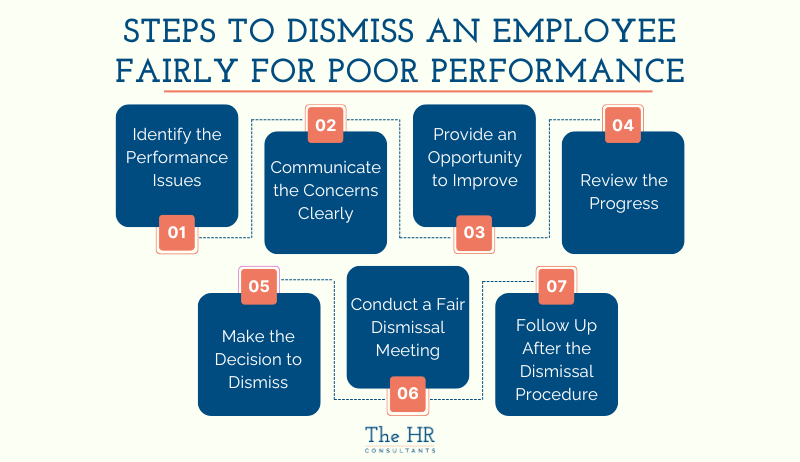"
Dismissing an employee for poor performance is never an easy decision, but handling the process fairly and legally is essential for protecting your business and maintaining workplace integrity. At The HR Consultants, we understand that small and medium-sized businesses may not know how to dismiss an employee. That’s why we’ve created this helpful blog to support you.
Let’s negotiate this sensitive process together, ensuring fairness for all involved while protecting your business from potential legal risks or threats from the arbitration service.
Table of Contents
- Understanding Employee Performance Issues
- Steps to Dismiss an Employee Fairly for Poor Performance
- Legal Considerations for Fair Dismissal
- Best Practices for Employers
- Wrapping Up
- Frequently Asked Questions
Understanding Employee Performance Issues
Managing employee performance can be a challenge for any business, but understanding the root of the issue is the first step in addressing it effectively. Performance issues, if left unchecked, can affect team morale, disrupt productivity, and even lead to costly legal disputes. Here, we’ll explore what constitutes poor performance and why it’s essential to tackle issues early.
What Constitutes Poor Performance?
Poor performance refers to an employee’s inability to meet the expectations of their role and employment contract, despite having the necessary resources and support.
Examples include:
Failing to meet deadlines
Consistently producing low-quality work
Struggling with essential tasks outlined in their job description
Please note: It’s important to differentiate performance issues from misconduct, such as violating company policies or ethical standards, which may require a different approach.

The Importance of Addressing Performance Issues Early
Addressing performance concerns promptly is vital. When issues are left unresolved, they can negatively impact team dynamics and reduce overall productivity. Moreover, early intervention often provides an opportunity for improvement, helping employees meet expectations while ensuring your business remains compliant with legal and ethical standards. Taking swift action demonstrates fairness and commitment to a positive workplace culture.
Steps to Dismiss an Employee Fairly for Poor Performance
Dismissing an employee is a sensitive process that must be handled with care to ensure impartiality, compliance, and professionalism. By following these steps, you can approach the situation with confidence and compassion while maintaining the integrity of your business.
Step 1: Identify the Performance Issues
Begin by reviewing the employee’s performance against measurable metrics like KPIs. Document specific examples of underperformance, such as missed deadlines or substandard work, to build a clear picture of the issue.
Step 2: Communicate the Concerns Clearly
Hold a one-on-one meeting with the employee to discuss your concerns. Explain how their performance is impacting the company and team. Keep the conversation professional and supportive, focusing on areas for improvement rather than blame.
Step 3: Provide an Opportunity to Improve
Set up a Performance Improvement Plan (PIP) outlining clear objectives, timelines, and resources available to help the employee improve. Offer support through training, mentoring, or additional tools to address the issues.
Step 4: Review the Progress
During the PIP period, schedule regular check-ins to track progress. Document any improvements or ongoing concerns, potentially with a final written warning should there be limited signs of progress. This promotes transparency and provides evidence if the objectives aren’t met.
Step 5: Make the Decision to Dismiss
Evaluate whether the employee has met the objectives set out in the PIP. Make sure your decision is unbiased, well-documented, and aligns with company policies.
Step 6: Conduct a Fair Dismissal Meeting
Prepare all necessary documents and invite relevant attendees, such as an HR representative. Communicate the decision with professionalism and empathy, allowing the employee to ask questions.
Step 7: Follow Up After the Dismissal Procedure
Finalise paperwork, including final salary and benefits. Where appropriate, offer career counselling or references to support the employee’s transition. This demonstrates professionalism and care for their future.

Preparing for an Employee’s Negative Reaction
Dismissals can be emotionally charged, and it’s crucial to anticipate and prepare for potential negative reactions from the employee. Approach the situation with empathy and professionalism. Before the meeting, rehearse what you plan to say, focusing on clear and objective reasoning.
Acknowledge the possibility of frustration or disappointment and remain calm if emotions escalate. Having an HR representative present can help mediate the discussion and provide additional support. Offer the employee a chance to express their concerns, but ensure the conversation stays constructive.
Being prepared for these reactions is vital to showcase your commitment to fairness and respect throughout the process.
Legal Considerations for Fair Dismissal
While considering your employee's wellbeing, you must also follow the law during the dismissal process.
Understanding Employment Laws
Under UK law, unfair dismissal claims can arise if proper procedures aren’t followed. Employers must demonstrate that the dismissal is for a fair reason, such as underperformance, and that a fair process was used. For detailed guidance on how to follow the correct procedure, refer to ACAS guidelines.
Probation periods provide an opportunity to assess an employee’s suitability for the role. However, dismissals during probation still require compliance with contractual notice periods and anti-discrimination laws. For employees on permanent contracts, you’ll need to follow a structured process, including setting expectations, offering support, and documenting steps taken to address the issues.
The Role of Documentation
Thorough documentation is your lifeline in case of disputes. Keep records of a formal written warning, performance reviews, one-on-one meetings, and any improvement plans, such as a Performance Improvement Plan (PIP). Include specific examples of underperformance, such as missed deadlines or client complaints, along with any actions taken to support the employee.
Ensure that all correspondence, including written warnings and follow-up emails, is clear, professional, and consistent. Meeting minutes and signed agreements are also crucial for showing that the process was transparent and collaborative.
Avoiding Discrimination Claims
To avoid unintentional bias, ensure that performance reviews and dismissal decisions are based on fair disciplinary process and solely on objective evidence and measurable outcomes. Always apply your organisation’s policies consistently across all employees.
Here are four key questions to ask yourself:
- Have I clearly documented the performance issues and provided objective evidence?
- Have I treated this employee the same as others in similar situations?
- Have I considered whether any disabilities or protected characteristics could be impacting performance?
- Have I provided reasonable adjustments or support where required?
Best Practices for Employers
As unpleasant as it can be, dismissing an employee fairly is an essential part of maintaining a productive and positive workplace. Beyond simply managing the process correctly, it’s also an opportunity to reflect on your company’s performance management practices and workplace culture.
Here, we’ll explore how to create a performance-driven environment, learn from past dismissals, and implement preventive measures to reduce future performance issues.
Cultivating a Performance-Driven Culture
A culture that values performance isn’t about pressuring employees to meet unattainable targets. Instead, it’s about creating an environment where expectations are clear, feedback is constructive, and support is readily available.
This approach benefits everyone—employees understand what’s expected of them, and managers can address performance concerns long before they become significant.
Here are practical ways to cultivate this culture:
- Encourage Open Communication: Employees should feel comfortable discussing challenges or asking for help without fear of judgment. For example, hosting regular one-to-one meetings allows team members to share concerns early, whether it’s workload-related stress or the need for additional training.
- Set Clear Expectations: Clarity is crucial. Job descriptions should be detailed, and performance metrics should be transparent. For instance, if a marketing manager is expected to generate a specific number of leads per month, this target should be clearly outlined during onboarding.
- Provide Regular Feedback: Quarterly performance reviews, coupled with informal check-ins, create a framework for ongoing dialogue. Feedback should focus on actionable insights—what’s going well and where improvements can be made. For example, instead of saying, “Your work isn’t up to standard,” try, “Let’s work on improving the accuracy of your reporting by double-checking data sources.”
- Recognise and Reward Good Performance: Employees who feel appreciated are more likely to engage with their work. Recognition can be as simple as a public “thank you” during team meetings or as formal as a performance-based bonus scheme.
- Invest in Employee Development: Supporting professional growth helps employees improve and benefits the organisation. Workshops, training courses, and mentorship programmes are all valuable tools.
Introducing bi-weekly feedback sessions after noticing recurring performance issues may be a practical way to tackle them. This proactive approach allows managers to address concerns before they escalate, resulting in higher productivity and fewer dismissals over time.

Learning from the Process
Every dismissal should prompt a moment of reflection. While it’s never the desired outcome, it provides an opportunity to assess what could have been done differently to prevent the situation.
Here’s how to approach this learning process:
- Review the Employee’s Journey: Look back at the employee’s tenure. Were there any warning signs early on? Did they receive the necessary support? If an employee struggled with deadlines, were they provided with time management tools or training?
- Evaluate the PIP: Assess the effectiveness of the Performance Improvement Plan. Were the goals realistic? Was there adequate time for improvement? If the employee failed to meet the objectives, consider whether the plan could have been clearer or more tailored to their needs.
- Gather Feedback: Don’t hesitate to ask for feedback from other team members or managers involved in the process. This can provide valuable insights into how the situation was handled and highlight areas for improvement.
- Consider Organisational Changes: Sometimes, underperformance isn’t solely the employee’s fault. Are there systemic issues within the organisation that need addressing, such as poor communication or lack of resources?
By reflecting on these aspects, you can refine your approach and reduce the likelihood of similar situations in the future. If repeated underperformance stems from unclear job descriptions, updating these documents could be a simple yet effective solution.
Implementing Preventive Measures
Prevention is always better than cure.
While it’s impossible to eliminate all performance issues, taking proactive steps can significantly reduce their occurrence. Here are some strategies to consider:
- Enhance Onboarding Processes: A strong onboarding programme sets the tone for an employee’s success. Use this time to clearly explain job expectations, provide necessary training, and introduce them to key team members, who possess experience, patience and confidence.
- Focus on Role Alignment: Sometimes, underperformance arises because an employee’s strengths don’t align with their role. Regularly reviewing job roles and responsibilities ensures employees are in positions that suit their skills and interests.
- Monitor Workload Distribution: Overwhelmed employees are more likely to struggle with performance. Check in with your team to ensure workloads are manageable and provide support where needed.
- Encourage Ongoing Training: Offering continuous professional development opportunities helps employees stay up-to-date with industry trends and improves their performance.
- Promote a Collaborative Environment: Teams that work well together are more productive and supportive. Create an atmosphere of collaboration through team-building activities, shared goals, and open communication channels.
Real-World Examples of Preventive Measures
- Case Study: Improved Onboarding
LinkedIn identifies several key elements that contribute to an effective onboarding process in their organisation:
- Pre-boarding Preparation: Engage new hires before their first day by providing essential information, completing paperwork, and setting clear expectations.
- Structured Orientation Programme: Implement a comprehensive programme that introduces company culture, values, and goals, ensuring new employees understand their role within the organisation.
- Role-Specific Training: Offer targeted training tailored to the employee's position, equipping them with the necessary skills and knowledge to perform effectively.
- Mentorship and Peer Support: Assign mentors or buddies to guide new hires, fostering a sense of belonging and providing a reliable resource for questions and support.
- Regular Check-Ins and Feedback: Schedule consistent meetings to assess progress, address concerns, and offer constructive feedback, promoting continuous development.
- Integration into Company Culture: Encourage participation in team activities and social events to help new employees build relationships and assimilate into the workplace environment.
- Case Study: Professional Development
Improving teacher professional development in England has been a strategic focus to enhance educational outcomes, particularly for disadvantaged students. Key steps taken include:
- Establishing a National Framework: The introduction of the Early Career Framework (ECF) provides structured support for new teachers, ensuring consistent and high-quality professional development across the country.
- Implementing Evidence-Based Programmes: Initiatives like the Accelerate Teaching Programme offer early career teachers access to research-informed training, promoting effective teaching practices.
- Promoting Collaborative Learning: The Schools Partnership Programme encourages peer-led school improvement, fostering a culture of joint practice development and shared accountability among educators.
- Enhancing Instructional Leadership: Focusing on the 'middle tier' of education systems, efforts have been made to empower district supervisors, pedagogical coaches, and teacher mentors to act as catalysts for change in local school reforms.
- Utilising Technology and Research: Resources like the Teacher Development Trust's TDT Advisor provide access to a database of professional development opportunities, enabling teachers to engage in continuous learning tailored to their needs.
Wrapping Up
Dismissing an employee for poor performance is undoubtedly challenging, but when handled fairly and professionally, it can reinforce your organisation’s commitment to integrity and high standards. By addressing performance issues early, documenting every step, and fostering a culture of support and accountability, you can navigate this process confidently.
Employment law specialists, such as ourselves, understand that these situations aren't easy, especially for businesses without dedicated HR teams. That’s why we’re here to help. Whether you need assistance creating Performance Improvement Plans, guidance on employment laws, or simply a sounding board for your concerns, we’ve got you covered.
Remember, every challenge is an opportunity to grow and improve—both for your business and your employees. Let’s work together to build a workplace that thrives on fairness, clarity, and mutual respect. If you’d like tailored advice for your business, contact us today.
[addCTA blink=""/services/ad-hoc-hr-consultancy/"" title=""Try our ad-hoc consultancy to help you navigate the process.""]
Frequently Asked Questions (FAQs)
Here are some frequently asked questions about how to dismiss an employee fairly.
What is the difference between dismissal and redundancy?
Dismissal refers to ending an employee’s contract, due to performance issues, misconduct, or other valid reasons. Redundancy occurs when a job role is no longer required, often due to organisational restructuring or cost-saving measures.
How long should a Performance Improvement Plan (PIP) last?
A Performance Improvement Plan (PIP) typically lasts 30 to 90 days, providing enough time for the employee to demonstrate measurable improvement. The exact timeline depends on the complexity of the issues being addressed.
What should I do if an employee refuses to engage in the PIP process?
If an employee refuses to participate in a PIP, document their refusal and clarify the process’s purpose. Emphasise how it supports their improvement. If they continue to resist, proceed with fair dismissal steps while maintaining proper documentation.
Can an employee be dismissed for poor performance during their probationary period?
Yes, employees can be dismissed during probation for poor performance, but the process must be full and fair procedure and follow company policies. Provide feedback, opportunities to improve, and comply with legal obligations, such as notice periods.
What are the risks of dismissing an employee without a documented process?
Dismissing an employee without proper documentation risks claims of wrongful dismissal or discrimination. A lack of records also weakens your ability to demonstrate fairness and compliance with UK employment law. Proper documentation protects your business from an employment tribunal."












